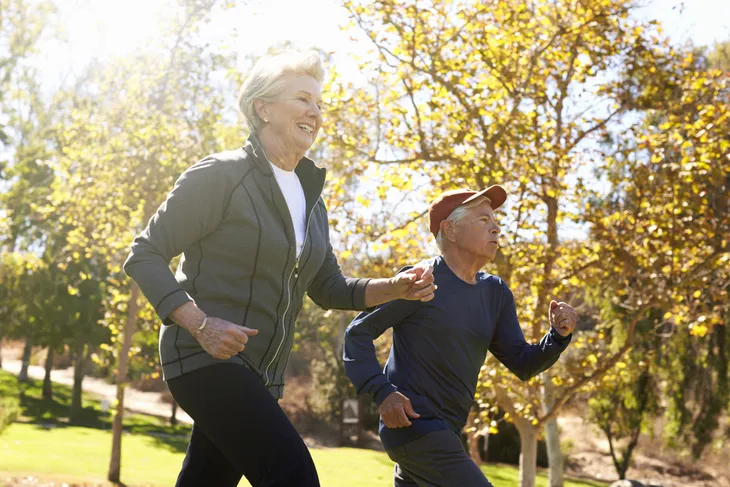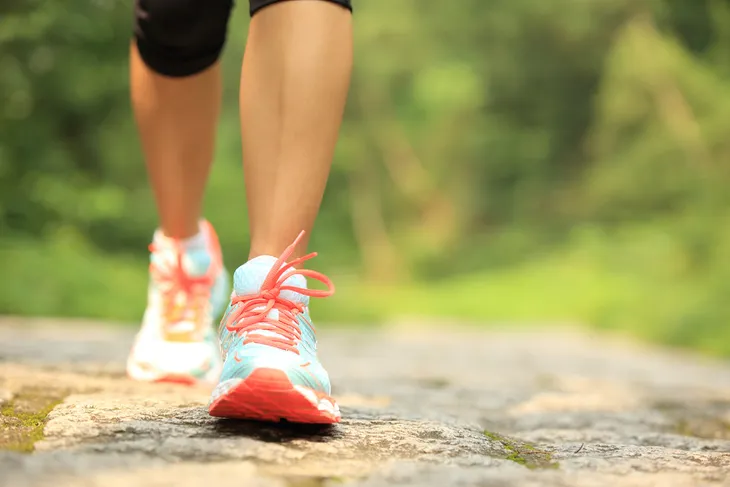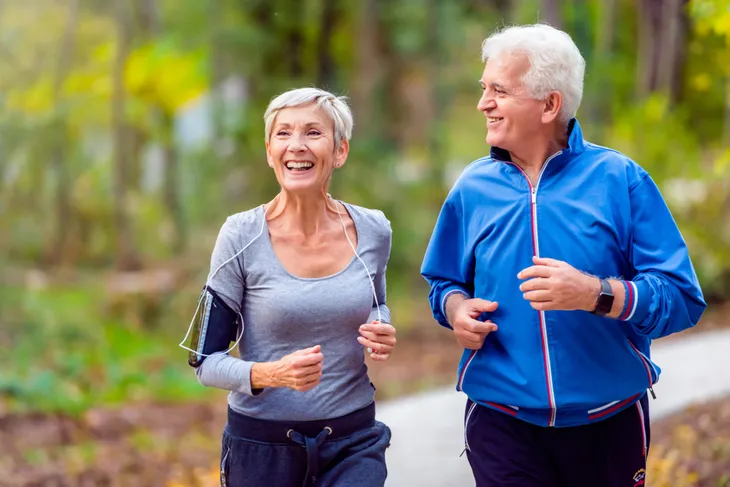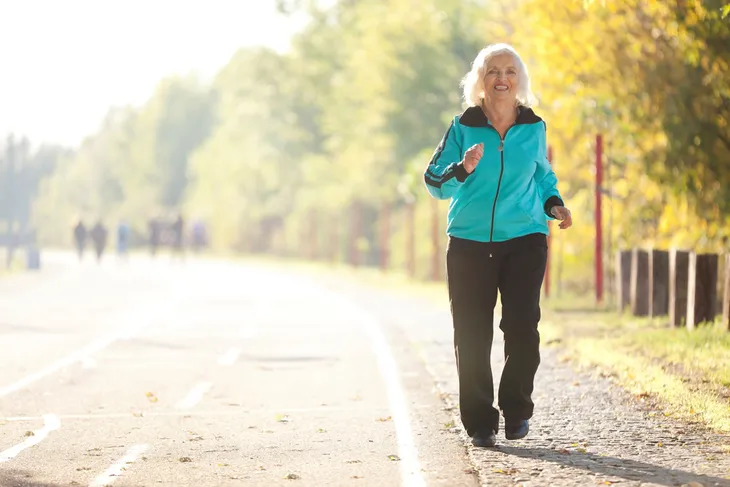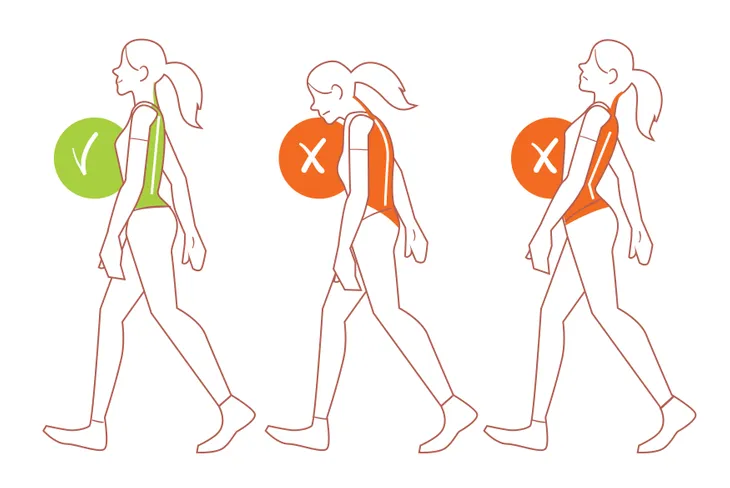If you’re overweight or at risk of developing type 2 diabetes, your doctor has likely recommended taking daily walks. Beginner exercise—even gentler forms, like walking—provides an efficient means of getting your blood sugar in check and reducing the risk of heart disease.
According to a study from George Washington University in Washington, D.C., walking for just 15-minutes after every meal improves glucose absorption—resulting in weight loss (or calories burned), and improved heart and muscle function.
So what are you waiting for? Walk this way for a better walking workout…
Walk Proud
According to research from the Mayo Clinic, you can walk your way to better health quite efficiently—as long as you do it with proper posture and purposeful movements. For instance, as you stride concentrate on keeping your spine straight. That means your ears and shoulders should sit directly above your hips, your head should not jut too far forward or back, but sit right above the neck.
Also, engage the core muscles by slightly squeezing your abdominal muscles. This will help keep your posture naturally aligned so that your lower back doesn’t arch too far forward or backward and cause an injury. Good walking posture will also energize your body by making exercise much easier and less problematic.
Pump Those Arms
Sure, your feet will take the lead as you perform your walking workout. However, your arms will also help guide you if you put a little energetic pump into your swing. By that I don’t mean you should swing your arms erratically or hold them too tightly.
Instead, let your arms hang naturally at your sides to start. Now let them swing naturally to and fro as you walk with a slight bend in your elbows. You’ll notice that your hands reach mid-breastbone height on your upswing and brush slightly past the hips on your downswing.
Shorten Your Stride
The same rule applies to your legs as it does to your arms—an energetic stride is encouraged, however, if your stride is too long or loose your body will bounce and you could sustain an injury to your knees, ankles, or hip joints.
As an alternative to a long, bouncy stride, shorten your steps and focus on purposeful movements at first. Instead of speed concentrate on coordination. As you take each step, roll the foot from heel to toe with smooth ease. This proper form will strengthen your bones and improve your balance so eventually you can accelerate your walking speed as well.
Track Steps with a Pedometer
If you’re having trouble getting motivated to walk, try counting your steps with a pedometer. According to a 2009 report from Harvard Medical School, strapping on a pedometer provides an inexpensive and effective means of motivation…it’s similar to having a walking coach or walking buddy for encouragement.
Harvard researchers reviewed 26 studies on the use of pedometers as motivational tools and found that when study participants wore a pedometer they walked 2000 additional steps compared to non-pedometer users. In the end, the study found that wearing a pedometer increased participant’s overall fitness levels by 27-percent.
Loosen Up
When I first started walking and then running, I did so with an upper body so clenched that my husband referred to me as “the Terminator.” While I might have appeared somewhat intimidating to passersby—the act of tightening up the muscles in my upper body redirected energy to muscles that weren’t aiding my workout. Hence, I was wasting valuable energy.
I’ve since learned to keep my body relaxed, which means loosening the tension in my jaw, face, and hands (so resist the urge to make fists as you walk). Focus on good posture, but keep your arms and shoulders relaxed and loose to power your walk.
Use a Heart Rate Monitor
Like a pedometer (that measures your steps) a heart rate monitor (that measures your pulse rate) is akin to having your own motivational trainer along for the walk. You can probably understand the benefits of having a wireless tool that straps to your wrist and provides real-time data on your exercise efficiency.
Wearing a heart rate monitor while you walk ensures you’re getting the most bang for you buck—meaning your walking at optimal intensity (approximately 75-percent of your max heart rate) for your efforts. A heart rate monitor will ensure you stay safe yet it will give you a little push if you reduce your walking speed.
Squeeze Through Your Glutes
Walking calls many muscles into play—primarily your glutes (the gluteus maximus, gluteus minimus and gluteus medius) or the large group of muscles located in the back of your legs and buttocks. These muscles stabilize your pelvis and spine, and control the flexion (forward movement), extension (backward movement), rotation (inward and outward movements), and abduction (side/away movements) of your hip joints.
Walking (and climbing stairs and running) is one of the few exercises that allow you to engage the glutes during exercise. Typically glute exercises are isolated, which means you focus on the glutes muscles only. However with walking you use other muscles as you give your glutes a squeeze. Envision your walking on pebbles or marbles as you walk. This multi-muscle sequence will help improve glute strength and stabilization.
Keep Your Eyes on the Prize
For those of you who don’t enjoy walking, the prize I’m referring to might very well might be your couch. However, considering that the average human head weighs between 7 – and 10-pounds, if you look down or stick your head to far forward or back as you walk, you could find yourself wishing for a chiropractor or massage therapist.
Walking and running experts from Tufts University, in Boston, Massachusetts recommend focusing your eyes on the horizon for a reason. Proper head alignment will keep your noggin supported in a neutral position as you stride. The easiest way to avoid a hazardous head position as you walk is to keep your head up, your airway expanded for deep breathing, chest open, and your eyes fixed on the horizon. This will ensure straight and level head and neck alignment.


